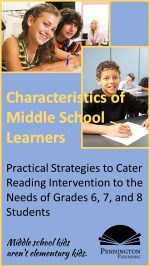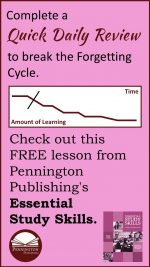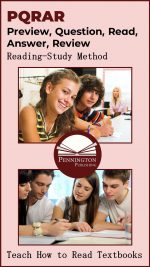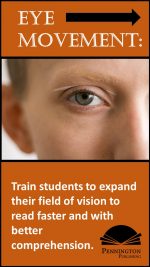
Test Prep Articles
Like most teachers, I teach test preparation strategies in my content area-English-language arts. I teach how to study and how to take tests. As an MA Reading Specialist, I happen to think that it’s an important reading skill. However, despite pressures from some to teach to the annual state and district standardized tests, I just smile and continue to teach to the established standards and to the needs of my students. In other words, I think I teach what I’m supposed to teach and to whom. Not all of my colleagues share my views. We just have a basic, honest disagreement on this matter.
Some of my colleagues support teaching “power standards” and use “release questions” to practice for the annual standardized tests. Some spend considerable amounts of time composing benchmark assessments in the standardized test format. Some colleagues plan mini-lessons to address relative weaknesses indicated through item analyses of the test data. Some minimize instruction in content and/or skills that are untested or seem to be relative strengths. Some plan and prioritize their instructional minutes and assessments to match the percentage allotment of test questions. If 7% of the subtest consists of word analysis questions, then they plan 7% of their instructional delivery time and 7% of the questions on their unit tests to match. Some essentially abandon instruction the last week or so prior to the standardized test in order to review test-taking strategies and practice test questions. The standardized test certainly does drive instruction for some teachers, and they readily admit that this is the case.
Now I’d like to report that my method of teaching to the standards and students produces superior standardized test results than my more zealous standardized test colleagues; however, states wisely have precluded this kind of data analysis. But, to be completely honest… If we were able to determine that my colleague achieved superior test scores, I doubt whether I would alter much of my instruction accordingly. I don’t think I’m stubborn or close-minded. I steal from my colleagues all the time, but I better trust the process of teaching to the standards and to my students than the process of teaching to the standardized test.
Following are articles, free resources, and teaching tips regarding how to prepare students for test preparation from the Pennington Publishing Blog. Bookmark and visit us often. Also, check out the quality instructional programs and resources offered by Pennington Publishing.
Test Preparation
How to Study in Advance for Tests
https://blog.penningtonpublishing.com/study_skills/how-to-study-in-advance-for-tests/
Although cramming for a test is somewhat effective, studying over a period of days prior to the test gets better results. Learn how to prepare in advance by practicing a daily review of notes, asking the right questions of the teacher, and forming a study group. This article details the best advance strategies for test success.
How to Take Tests
https://blog.penningtonpublishing.com/study_skills/how-to-take-tests/
Although your effective test study does increase the likelihood of test success, it is only half of the equation. The other critical half is how you take the test. Developing a test plan will reduce stress, manage time, and maximize success. This article details the best strategies for taking a test.
How to Reduce Test Anxiety
https://blog.penningtonpublishing.com/study_skills/how-to-reduce-test-anxiety/
Test anxiety plagues students of all ages. This article teaches you how to relax and build test-taking confidence with positive self-talk and practical strategies.
The Phenomenal Five Objective Test Tips
https://blog.penningtonpublishing.com/study_skills/the-phenomenal-five-objective-test-tips/
Objective tests pose many problems for test-takers. Knowing the strategies of how to answer multiple choice, matching, fill in the blank, and true-false test problems can significantly improve ones overall test scores. This article details the five best objective test-taking strategies.
How to Take Multiple Choice Tests
https://blog.penningtonpublishing.com/study_skills/how-to-take-multiple-choice-tests/
Learn how to strategically guess on multiple choice sections. These multiple choice tips will help you get the grade you want by eliminating selection mistakes. Learn how multiple choice tests are constructed and take advantage of this to maximize your test score. Hint: the answer isn’t always “C.”
The Top Nine Tips to Taking True-False Tests
https://blog.penningtonpublishing.com/study_skills/the-top-nine-tips-to-taking-true-false-tests/
Students say that they like true-false tests; however, it is hard to earn an A on these types of tests. This article details the tips that will maximize your scores on these test sections. Learn how to strategically guess on true-false tests. Everything you learn will be true, of course.
The Top Ten Tips to Taking Matching Tests
https://blog.penningtonpublishing.com/study_skills/the-top-ten-tips-to-taking-matching-tests/
Learn how to strategically guess on matching sections. These tips will help you get the grade you want by eliminating selection mistakes. Learn how matching tests are constructed and take advantage of this to maximize your test score.
Top Ten Memory Tips
https://blog.penningtonpublishing.com/study_skills/top-ten-memory-tips/
Improving memory helps in all walks of life: business, school, and relationships. Learning and applying the Top Ten Memory Tips will significantly improve your short and long term memory. Who knows? After reading this list, you just might remember where you left your car keys.
How to Memorize Using the Grouping Technique
https://blog.penningtonpublishing.com/study_skills/how-to-memorize-using-the-grouping-technique/
This simple memory technique will help students of all ages place many items into the long term memory. Using the grouping technique, the seeming trivia of the academic disciplines is organized into meaningful and memorable categories. Score higher on tests and make study fun by learning the way our brains are organized.
How to Memorize Using the Catch Words Technique
https://blog.penningtonpublishing.com/study_skills/how-to-memorize-using-the-catch-words-technique/
Improve your long term memory by using catch words. Students will especially appreciate how catch words will help organize their test study. Catch words are useful for simple day to day facts that need to be memorized. You may also figure out why “ROY G. BIV” has helped millions remember the colors of the rainbow in order.
How to Memorize Using the Catch Sentences Technique
https://blog.penningtonpublishing.com/study_skills/how-to-memorize-using-the-catch-sentences-technique/
Learn how to significantly improve your long term memory by using catch sentences. Students will especially love how catch sentences will help organize their test study. Catch sentences are useful for many aspects of daily life. You may also figure out why “Every good boy does fine” has helped millions learn to play the piano.
How to Memorize Using the Association Technique
https://blog.penningtonpublishing.com/study_skills/how-to-memorize-using-the-association-technique/
Need to improve your long term memory? The association memory trick will help students prepare more efficiently for tests. The trick will help sales people remember names. Learn how to significantly improve your long term memory by using catch sentences. You may also find out how the memory experts can memorize the names of an entire studio audience.
How to Memorize Using the Linking Technique
https://blog.penningtonpublishing.com/study_skills/how-to-memorize-using-the-linking-technique/
The linking memory technique is one of the best memory methods to memorize lists of seemingly unrelated objects. Learn how to significantly improve your long term memory by using the linking strategies. Once you’ve made a link, you won’t have to think—you’ll just remember.
How to Memorize Using the Location Memory Technique
https://blog.penningtonpublishing.com/study_skills/how-to-memorize-using-the-location-memory-technique/
Location! Location! Location! The real estate professionals haven’t cornered the market on this strategy. Developed by the ancient Greeks, using familiar locations to memorize many ideas or objects has always proved a full-proof method of memorization. Have a speech or business presentation? This article will give you the tools to place the words into your long term memory.
How to Memorize Using the This Old Man Technique
https://blog.penningtonpublishing.com/study_skills/how-to-memorize-using-the-%E2%80%9Cthis-old-man%E2%80%9D-technique/
Who would think that a simple nursery rhyme, “This Old Man,” could help you memorize ten completely unrelated items in perfect order. Great for a business presentation. Useful for test study. Wonderful for a grocery or any to-do list. Once learned, the information will be retained in the long term memory.
The Sweet Sixteen Strategies for SAT® Success
https://blog.penningtonpublishing.com/study_skills/the-sweet-sixteen-strategies-for-sat®-success/
Just sixteen general strategies will help you make a significant difference on both the SAT® and ACT® test. Warning: Don’t assume you already know these tips; these are not just “common sense” test-taking strategies. Use these strategies with readily available online practice tests and watch your scores improve.
How to Answer the SAT® Sentence Completion Test Problems
https://blog.penningtonpublishing.com/reading/how-to-answer-the-sat-sentence-completion-test-problems/
Most SAT®-takers generally think that the SAT sentence completion sections are relatively easy. After all, they are just fill in the blanks. However, many students can be shocked to find out that their test results in this section can be lower than those from the passage-based sections. This article shares the best strategies to help SAT-takers significantly increase their SAT scores on the sentence completion test problems.
How to Answer the SAT® Passage-Based Reading Test Problems
https://blog.penningtonpublishing.com/reading/how-to-answer-the-sat-passage-based-reading-test-problems/
The SAT passage-based reading sections can create a stumbling block for SAT test-takers. Many students score poorly on these sections; however, using the memorable strategies explained in this article will help SAT-takers significantly increase their SAT scores on the passage-based critical reading section. Learn how to beat the SAT with these effective strategies.
How to Get a 12 on the SAT® Essay
https://blog.penningtonpublishing.com/writing/how-to-get-a-12-on-the-sat-essay/
The SAT essay can produce time management challenges and difficulties for SAT-takers. Many students score poorly on this section; however, using the AEC TP IT 2B RCP strategies will help SAT-takers significantly increase their SAT scores on the SAT essay section.
How to Learn SAT® Vocabulary
https://blog.penningtonpublishing.com/spelling_vocabulary/how-to-learn-sat-vocabulary/
SAT®-takers find the critical reading sections challenging because both the sentence completion and passage-based reading sections are so vocabulary dependent. You may not have a huge academic vocabulary, but some concentrated study and knowing the following strategies can make a significant difference in your scores. Here are the short-cuts you need to succeed.
More Articles, Free Resources, and Teaching Tips from the Pennington Publishing Blog
 English-Language Arts and Reading Intervention Articles and Resources
English-Language Arts and Reading Intervention Articles and Resources
Bookmark and check back often for new articles and free ELA/reading resources from Pennington Publishing.
*****

Essential Study Skills
Pennington Publishing’s mission is to provide the finest in assessment-based ELA and reading intervention resources for grades 4‒high school teachers. Mark Pennington is the author of many printable and digital programs. Please check out Pennington Publishing for assessment-based resources created for teachers by a fellow teacher.
Grammar/Mechanics, Reading, Spelling/Vocabulary, Study Skills, Writing
ACT, Advisory, Advocacy, Art Costa, AVID, Bloom's Taxonomy, Bloom’s Levels of Questions, Cornell Notes, Costa’s Levels of Questioning, critical thinking, CST, CST release questions, free standardized test practice, free standardized test prep, free standardized test preparation, free test practice, free test prep, free test prep curriculum, free test preparation, free test preparation curriculum, goal setting, higher order thinking, Leadership Classes, Mark Pennington, memorization, memory tips, memory tricks, motivation, note taking, organization, practice tests, problem solving, procrastination, reading comprehension, review, SAT, SQ3R, standardized test practice, standardized tests, standards-based test prep, STAR, study method, study skills, test practice, test prep, test preparation, test study, test-taking, Think Alouds, time management, time on task, workplace efficiency, workplace organization
 English-Language Arts and Reading Intervention Articles and Resources
English-Language Arts and Reading Intervention Articles and Resources 












